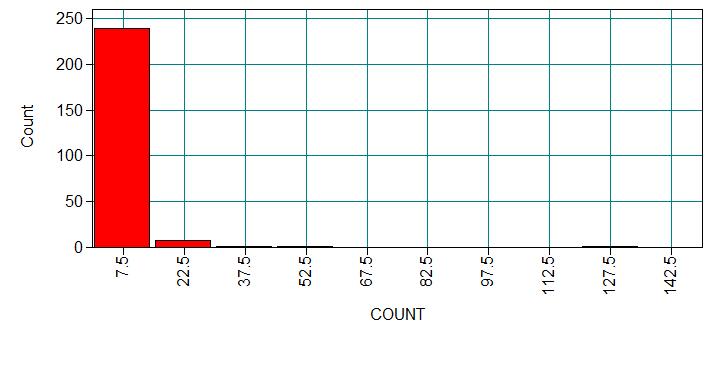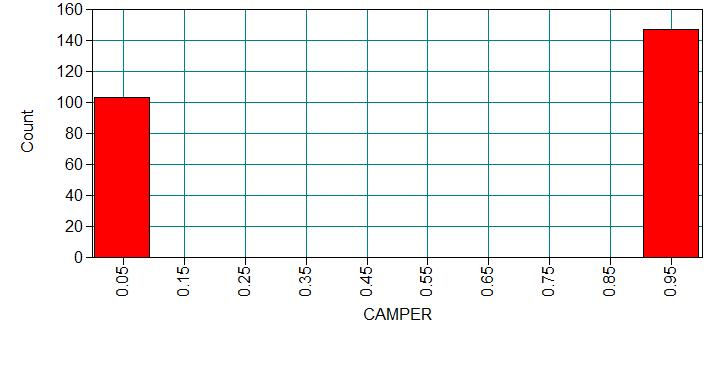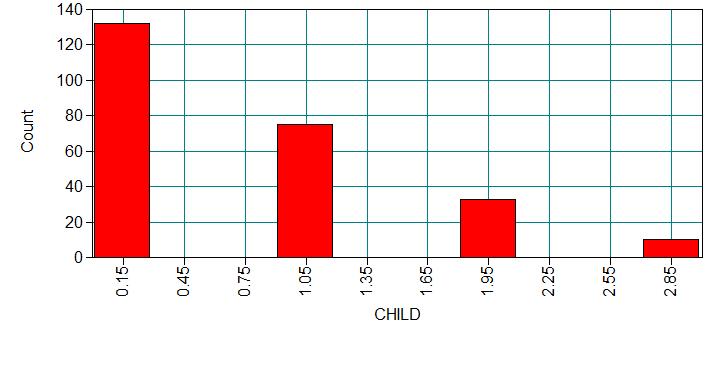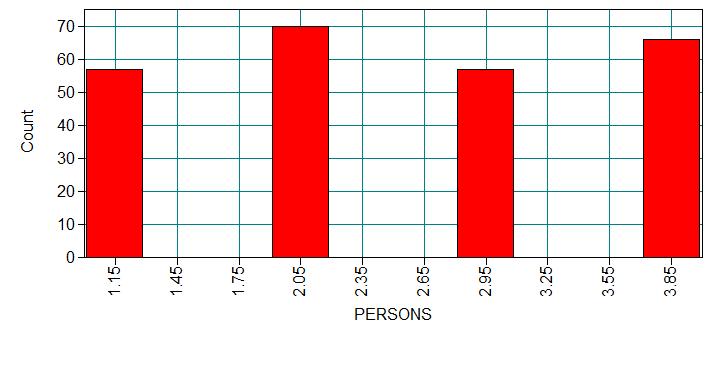Version info: Code for this page was tested in Mplus version 6.12.
Zero-inflated negative binomial regression is for modeling count variables with excessive zeros and it is usually for overdispersed count outcome variables. Furthermore, theory suggests that the excess zeros are generated by a separate process from the count values and that the excess zeros can be modeled independently.
Please note: The purpose of this page is to show how to use various data analysis commands. It does not cover all aspects of the research process which researchers are expected to do. In particular, it does not cover data cleaning and checking, verification of assumptions, model diagnostics or potential follow-up analyses.
Examples of zero-inflated negative binomial regression
Example 1.
School administrators study the attendance behavior of high school juniors at two schools. Predictors of the number of days of absence include gender of the student and standardized test scores in math and language arts.
Example 2.
The state wildlife biologists want to model how many fish are being caught by fishermen at a state park. Visitors are asked how long they stayed, how many people were in the group, were there children in the group and how many fish were caught. Some visitors do not fish, but there is no data on whether a person fished or not. Some visitors who did fish did not catch any fish so there are excess zeros in the data because of the people that did not fish.
Description of the data
Let’s pursue Example 2 from above. The associated dataset can be found here.
We have data on 250 groups that went to a park. Each group was questioned before leaving the park about how many fish they caught (count), how many children were in the group (child), how many people were in the group (persons), and whether or not they brought a camper to the park (camper). The outcome variable of interest will be the number of fish caught. Even though the question about the number of fish caught was asked to everyone, it does not mean that everyone went fishing. What would be the reason for someone to report a zero count? Was it because this person was unlucky and didn’t catch any fish, or was it because this person didn’t go fishing at all? If a person didn’t go fishing, the outcome would be always zero. Otherwise, if a person went to fishing, the count could be zero or non-zero. So we can see that there seemed to be two processes that would generate zero counts: unlucky in fishing or didn’t go fishing.
Let’s first look at the data. We will start with reading in the data and the descriptive statistics and plots. This helps us understand the data and give us some hint on how we should model the data.
Let’s look at the data.
Data:
File is C:fish.dat;
Variable:
Names are
nofish livebait camper persons child xb zg count;
Missing are all (-9999);
Usevariables are
camper persons child count;
Analysis:
type = basic;
plot: type is plot1;
ESTIMATED SAMPLE STATISTICS
Means
CAMPER PERSONS CHILD COUNT
________ ________ ________ ________
1 0.588 2.528 0.684 3.296
Covariances
CAMPER PERSONS CHILD COUNT
________ ________ ________ ________
CAMPER 0.242
PERSONS -0.026 1.233
CHILD -0.014 0.515 0.720
COUNT 0.730 2.856 -1.670 134.832
Correlations
CAMPER PERSONS CHILD COUNT
________ ________ ________ ________
CAMPER 1.000
PERSONS -0.048 1.000
CHILD -0.034 0.546 1.000
COUNT 0.128 0.221 -0.170 1.000




Analysis methods you might consider
Before we show how you can analyze this with a zero-inflated negative binomial analysis, let’s consider some other methods that you might use.
- OLS Regression – You could try to analyze these data using OLS regression. However, count data are highly non-normal and are not well estimated by OLS regression.
- Zero-inflated Poisson Regression – Zero-inflated Poisson regression does better when the data is not overdispersed, i.e. when variance is not much larger than the mean.
- Ordinary Count Models – Poisson or negative binomial models might be more appropriate if there are not excess zeros.
Zero-inflated negative binomial regression
In the syntax below, we have indicated that count is a count variable by using the count statement. The (nbi) option is used to indicate 2 things: that we are modeling our count variable with a negative binomial distribution, and that we are specifying a zero-inflated model. Without the (nb) option we would be specifying a (zero-inflated) poisson model, and without the (i) option, we would be estimating a negative binomial model without zero-inflation. Also, we use the usevariables statement to indicate that we are not using all of the variables in the data set in the current model. We have omitted the missing statement because we have no missing data in this data set. The default estimation method is MLR – maximum likelihood parameter estimates with standard errors and a chi-square test statistic that are robust to non-normality and non-independence of observations when used with type = complex. The MLR standard errors are computed using a sandwich estimator. This is what we generally call robust standard errors. To get the "regular" standard errors, we use the estimator = ml on the analysis statement. Two regression equations are specified in the model statement: the first equation is the negative binomial model, predicting the count of fish using child and camper. The second equation is the logit model, indicated by count#1, predicting membership to the zero generating process using persons.
Data:
File is C:fish.dat;
Variable:
Names are
nofish livebait camper persons child xb zg count;
Count is count(nbi);
Usevariables are camper persons child count;
Analysis:
estimator = ml;
Model:
count on child camper;
count#1 on persons;
MODEL RESULTS
Two-Tailed
Estimate S.E. Est./S.E. P-Value
COUNT ON
CHILD -1.515 0.196 -7.747 0.000
CAMPER 0.879 0.269 3.265 0.001
COUNT#1 ON
PERSONS -1.666 0.679 -2.454 0.014
Intercepts
COUNT#1 1.603 0.836 1.916 0.055
COUNT 1.371 0.256 5.353 0.000
Dispersion
COUNT 2.679 0.471 5.683 0.000
In the MODEL FIT INFORMATION portion of the output, you will find the log likelihood for the final model as well as a number of fit statistics. In the MODEL RESULTS section of the output you will find the negative binomial regression coefficients (estimates) for each of the variables, standard errors and the ratio of the estimate to its standard error. This can be used as a Z test, where values greater than 2 are considered to be statistically significant. Following these are logit coefficients for predicting excess zeros. In the above output, we see that both child and camper are significant predictor of count, and persons is a significant predictor in the logit model. Thus for each additional child, the log count of number of fish count decreases by 1.515. For each additional person, the log odds of membership to the excess zero-generating process decreases by1.666.
Now let’s rerun the model without the analysis statement in order to obtain robust standard errors.
Data:
File is C:fish.dat;
Variable:
Names are
nofish livebait camper persons child xb zg count;
Count is count(nbi);
Usevariables are camper persons child count;
Model:
count on child camper;
count#1 on persons;
MODEL FIT INFORMATION
Number of Free Parameters 6
Loglikelihood
H0 Value -432.891
H0 Scaling Correction Factor 1.762
for MLR
Information Criteria
Akaike (AIC) 877.782
Bayesian (BIC) 898.911
Sample-Size Adjusted BIC 879.890
(n* = (n + 2) / 24)
MODEL RESULTS
Two-Tailed
Estimate S.E. Est./S.E. P-Value
COUNT ON
CHILD -1.515 0.241 -6.280 0.000
CAMPER 0.879 0.470 1.869 0.062
COUNT#1 ON
PERSONS -1.666 0.431 -3.871 0.000
Intercepts
COUNT#1 1.603 0.665 2.410 0.016
COUNT 1.371 0.389 3.520 0.000
Dispersion
COUNT 2.679 0.577 4.645 0.000
The robust standard errors attempt to adjust for heterogeneity in the model. Robust standard errors tend to be larger than "regular" standard errors for parameters in the negative binomial part of the model and smaller for parameters in the logit part of the model. We see that now camper is not statistically significant.
Things to consider
Here are some issues that you may want to consider in the course of your research analysis.
- Question about the over-dispersion parameter is in general a tricky one. A large over-dispersion parameter could be due to a miss-specified model or could be due to a real process with over-dispersion. Adding an over-dispersion problem does not necessarily improve a miss-specified model.
- The zinb model has two parts, a negative binomial count model and the logit model for predicting excess zeros, so you might want to review these Data Analysis Example pages, Negative Binomial Regression and Logit Regression.
- Since zinb has both a count model and a logit model, each of the two models should have good predictors. The two models do not necessarily need to use the same predictors.
- Problems of perfect prediction, separation or partial separation can occur in the logistic part of the zero-inflated model.
- Count data often use exposure variable to indicate the number of times the event could have happened.
- It is not recommended that zero-inflated negative binomial models be applied to small samples. What constitutes a small sample does not seem to be clearly defined in the literature.
- Pseudo-R-squared values differ from OLS R-squareds, please see FAQ: What are pseudo R-squareds? for a discussion on this issue.
References
- Long, J. Scott (1997). Regression Models for Categorical and Limited Dependent Variables. Thousand Oaks, CA: Sage Publications.
